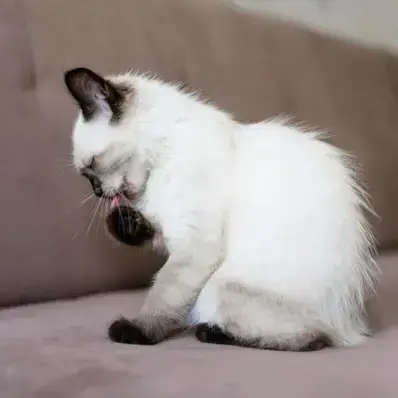How To Spot Cat Acne?
Identifying cat acne is crucial for maintaining your feline friend’s well-being. Keep a close watch on your cat’s physical appearance, especially around the chin and lips.
Here are some things you can look out for:
- Pay attention to the chin area. One of the first signs of feline chin acne is a dirty-looking chin.
- Look for small, black dots resembling blackheads or whiteheads, often accompanied by redness or inflammation.
- Check the fur texture in the affected area; if it appears greasy or there are changes in texture, it could be a sign of cat acne.
- Pay attention to your cat’s behavior – excessive scratching, pawing at the face, or rubbing against objects may indicate discomfort.
- Monitor eating and grooming habits, as cat acne can affect these routines.
- Additionally, watch for any signs of secondary infections, such as pus-filled lesions or open sores.
Regular observations during grooming sessions will help you catch cat acne early, ensuring timely and effective management. If you notice any of these signs, consulting with a veterinarian is advisable for a thorough examination and appropriate guidance on treatment options.
What are the Causes of Cat Acne?
Understanding the underlying factors that contribute to cat acne is crucial for effective prevention and management. Several elements can trigger the development of acne in cats, with the primary causes including:
- Excess Sebum Production
Cats have sebaceous glands in their skin that produce sebum, an oily substance. An overproduction of sebum can lead to clogged hair follicles, creating an environment conducive to acne development.
- Poor Grooming Habits
Cats are thorough groomers, but some may not effectively clean their chin and lip areas. Inadequate grooming can result in the accumulation of dirt, oil, and dead skin cells, contributing to acne.
- Plastic Bowls and Allergies
The material of your cat’s food and water bowls matters. Plastic bowls, in particular, can harbor bacteria and cause allergic reactions, leading to acne. Consider using stainless steel or ceramic bowls.
- Contact Irritants
Exposure to irritants in the environment, such as certain cleaning products or chemicals, can contribute to cat acne. Cats may come into contact with these substances and develop skin issues as a result.
- Stress and Hormonal Changes
Stress and hormonal fluctuations can impact a cat’s overall health, including the condition of their skin. Changes in the household, a new pet, or other stressors may contribute to the development of cat acne.
- Weakened Immune System
Cats with compromised immune systems may be more susceptible to skin conditions, including acne. It’s essential to address any underlying health issues to strengthen the immune response.
Identifying and addressing these potential causes is essential for managing and preventing cat acne.
Treatments for Cat Acne
Addressing cat acne involves a combination of home care and, in some cases, professional veterinary intervention.
Here are various treatment options to help manage and alleviate cat acne:
Topical Treatments
Applying cat-friendly topical treatments can help cleanse the affected area. These may include medicated wipes or solutions containing ingredients like benzoyl peroxide. Gently clean your cat’s chin or lip area to remove excess oil and debris.
Antibiotics and Medications
In severe cases, vets may prescribe antibiotics or other medications, including topical preparations, to combat bacterial overgrowth and reduce inflammation. Follow the prescribed dosage and complete the entire course of medication.
Home Remedies
Some cat acne home treatments can aid in managing cat acne. These may include diluted apple cider vinegar or mild antiseptic solutions for cleaning the affected area. Ensure any home remedy is safe for cats and consult with your veterinarian before use.
Grooming Practices
Regular grooming can prevent the accumulation of dirt and oil on your cat’s chin. Use a cat-specific brush to remove dead skin cells and distribute natural oils. Be gentle to avoid causing further irritation.
Switching to Stainless Steel or Ceramic Bowls
Replace plastic food and water bowls with stainless steel or ceramic alternatives. These materials are less likely to harbor bacteria, reducing the risk of allergic reactions that can contribute to cat acne.
Environmental Modifications
Create a stress-free environment for your cat by minimizing changes in their surroundings. Ensure they have a quiet and comfortable space to retreat to, especially if there have been recent changes in the household.
Dietary Adjustments
Consult with your veterinarian to explore potential dietary changes that may benefit your cat’s skin health. Omega-3 fatty acids and other skin-supporting nutrients can be incorporated into their diet.
Regular Veterinary Check-ups
Schedule regular veterinary check-ups to monitor your cat’s overall health. Your veterinarian can provide guidance on managing existing acne and help prevent future outbreaks.
It’s important to note that treatment effectiveness may vary among individual cats. If you observe worsening symptoms, consult with your veterinarian for a comprehensive evaluation and personalized treatment plan for your furry companion.
How To Clean Cat Acne?
Proper cleaning is a crucial aspect of managing cat acne and promoting overall skin health. Here are some tips and home treatments, including the use of a cat acne brush and witch hazel, to effectively clean cat acne:
- Gentle Brushing: Use a cat acne brush to delicately remove dirt and dead skin cells, preventing oil accumulation and reducing the risk of cat acne.
- Avoid Scented Products: Opt for mild, fragrance-free cat wipes or damp cotton pads to clean the affected area without causing irritation.
- Witch Hazel Solution: Dampen a cotton ball with alcohol-free witch hazel and gently wipe the acne-prone area for its soothing properties.
- Warm Compress: Apply a warm compress using a clean cloth or cotton pad soaked in warm water to open up pores and promote drainage.
- Cat-Friendly Cleansing Solutions: Use cat-specific cleansing solutions or wipes designed for feline acne, ensuring they are gentle on sensitive skin.
- Regular Cleaning Routine: Establish a consistent cleaning routine, addressing the acne-prone areas daily or as recommended by your veterinarian.
- Monitor Cat Acne Nose Area: Check around the nose for signs of acne and include it in your regular cleaning routine if needed.
Remember to approach the cleaning process with patience and gentleness. Improved hygiene and consistent cleaning can help in managing and preventing cat acne effectively.



